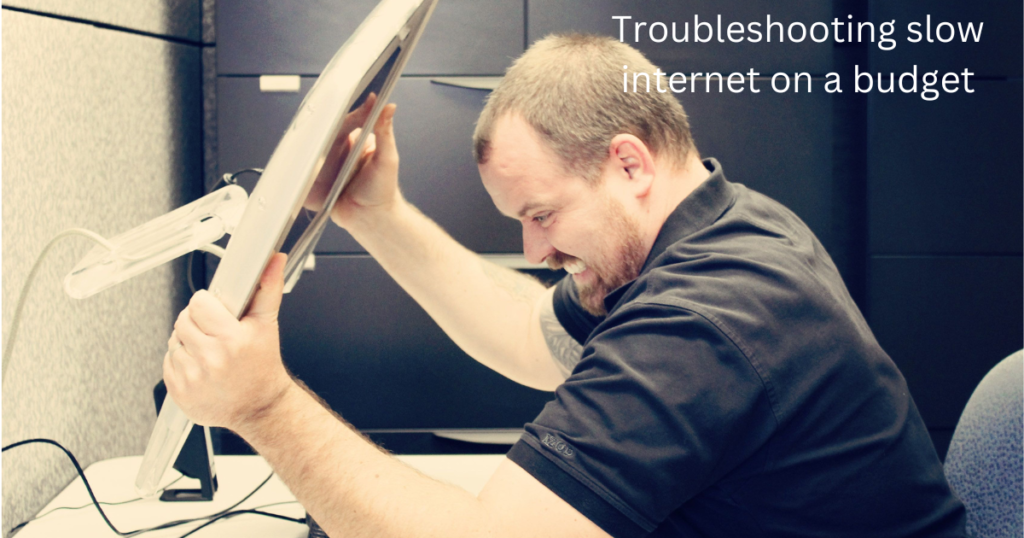Introduction
In today’s fast-paced digital world, a slow internet connection can feel like a roadblock to productivity, entertainment, and staying connected. Whether you’re streaming your favorite show, working from home, or gaming with friends, sluggish speeds can be a real frustration. The good news? You don’t need to break the bank to fix it. In this guide, we’ll walk you through practical, budget-friendly steps to troubleshoot slow internet and get your connection back up to speed in 2025. From simple DIY fixes to clever workarounds, we’ve got you covered—no expensive tech support required.
Let’s dive into actionable tips that anyone can use to diagnose and improve their internet performance without spending a fortune.
Why Is My Internet So Slow? Understanding the Basics
Before jumping into solutions, it’s helpful to understand why your internet might be lagging. Slow speeds can stem from a variety of causes, including outdated equipment, network congestion, or even sneaky bandwidth hogs in your home. In 2025, with more devices connected than ever—smart TVs, phones, laptops, and IoT gadgets—it’s easier for your network to get overwhelmed. The goal of troubleshooting on a budget is to identify the problem and fix it with minimal cost.
Here’s how to get started.
Step 1: Run a Speed Test to Diagnose the Issue
The first step in troubleshooting slow internet is to measure your current speed. You don’t need fancy tools—just a free online speed test tool will do. Websites like Speedtest.net or Fast.com are reliable and easy to use. Open your browser, run the test, and note your download and upload speeds. Compare these numbers to what your internet service provider (ISP) promised in your plan.
If the results are far below what you’re paying for, you’ve got a starting point. If they’re close to the advertised speed but still feel slow, the issue might be within your home network. Either way, this step costs nothing and gives you a clear picture.
Pro Tip: Run the test at different times of day. Peak hours (like evenings) often slow down shared networks, especially in budget plans.
Step 2: Restart Your Router—Yes, It Works!
It might sound like tech support’s oldest trick, but rebooting your router can solve a surprising number of issues. Over time, routers can glitch or overheat, causing performance dips. Unplug it, wait 30 seconds, and plug it back in. This resets the connection to your ISP and clears any temporary hiccups.
In 2025, many budget routers come with companion apps that let you reboot remotely. If yours doesn’t, a manual restart is just as effective—and free!
Step 3: Optimize Your Wi-Fi Placement
Where your router sits can make or break your internet speed. Walls, furniture, and even appliances like microwaves can interfere with Wi-Fi signals. For a budget-friendly fix, move your router to a central, elevated spot in your home. Avoid corners, closets, or spots near thick concrete walls.
If relocating isn’t an option, try adjusting the antennas (if your router has them) or placing a DIY reflector—like aluminum foil—behind the router to direct the signal. It’s a low-cost hack that can boost coverage without buying extenders.
Step 4: Check for Bandwidth Hogs
Got roommates or family members streaming 4K videos while you’re trying to work? Multiple devices can strain a budget internet plan. To troubleshoot slow internet on a budget, identify what’s eating your bandwidth. Log into your router’s admin page (usually accessible via an IP address like 192.168.1.1—check your manual) and look for connected devices.
If you spot unfamiliar gadgets, someone might be leaching your Wi-Fi. Change your password to something strong and unique. If it’s just your household, politely ask heavy users to limit usage during peak times—or schedule downloads for off-hours.
Budget Bonus: Many modern routers let you prioritize devices (like your work laptop) for free via Quality of Service (QoS) settings.
Step 5: Update Your Router’s Firmware
Outdated firmware can slow your router down or leave it vulnerable to bugs. Most manufacturers release free updates to improve performance. Log into your router’s admin page and check for a firmware update section. If there’s an option to download and install, follow the prompts. This takes a few minutes and costs nothing.
In 2025, some budget-friendly routers even notify you of updates via their apps. Don’t skip this step—it’s like giving your router a free tune-up.
Step 6: Switch to a Wired Connection
Wi-Fi is convenient, but it’s not always the fastest. If your device is near the router, grab an Ethernet cable and plug in. A decent cable costs less than $10, and it delivers a more stable, speedy connection—perfect for gaming or video calls. In 2025, with budget ISPs offering higher speeds, a wired setup ensures you’re getting every megabit you pay for.
No spare cable? Check your old tech drawers—chances are you’ve got one lying around.
Step 7: Limit Background Data Usage
Your devices might be secretly gobbling bandwidth. On phones and computers, apps like cloud backups, software updates, or streaming services can run in the background. To troubleshoot slow internet on a budget, take control:
- Windows/Mac: Go to settings and pause automatic updates.
- Smartphones: Restrict background data in app settings.
- Smart TVs: Disable auto-play features on streaming apps.
This tweak costs nothing and can free up bandwidth instantly.
Step 8: Contact Your ISP (Strategically)
If your speed test shows you’re not getting what you pay for, it’s time to call your ISP. Before you dial, gather evidence: screenshots of speed tests, dates, and times. Politely explain the issue and ask if they can reset your connection remotely or check for outages. In 2025, many budget ISPs offer live chat support—use it to avoid hold times.
Don’t be afraid to negotiate. Mention competitor plans (research them first) and ask for a discount or free speed boost. You’d be surprised how often this works without extra cost.
Step 9: DIY Wi-Fi Extenders or Alternatives
If weak signals are the culprit and relocation doesn’t cut it, consider a budget-friendly boost. Wi-Fi extenders can be pricey, but you’ve got options:
- Old Router Trick: If you have a spare router, set it up as a repeater. Free tutorials online walk you through it.
- Powerline Adapters: These use your home’s electrical wiring to extend internet. Budget models start at $20-$30 in 2025.
- Mobile Hotspot: If your phone plan includes data, use it as a temporary hotspot for critical tasks.
These solutions stretch your signal without a full network overhaul.
Step 10: Monitor and Maintain
Once your internet’s running smoothly, keep it that way. Regularly check for speed drops, update passwords, and reboot your router monthly. In 2025, free apps like Wi-Fi Analyzer (for Android) or built-in diagnostics on budget routers can help you spot issues early. Prevention is the ultimate budget fix.
When to Upgrade (Without Overspending)
If all else fails, your equipment or plan might be the bottleneck. Before splurging, weigh your options. In 2025, budget routers with Wi-Fi 6 support (like TP-Link’s Archer series) start under $50 and handle modern demands better. For plans, look for promotional deals—ISPs often slash prices for new customers or bundle extras like streaming subscriptions.
Compare costs versus benefits. A small upgrade might save you headaches long-term.
FAQs: Troubleshooting Slow Internet on a Budget
1. How can I tell if my slow internet is my ISP’s fault?
Run a speed test and compare the results to your plan’s advertised speed. If it’s consistently lower, contact your ISP with evidence.
2. What’s the cheapest way to boost my Wi-Fi signal?
Move your router to a central spot or use a DIY reflector like foil. Repurposing an old router as a repeater is another free option.
3. Do I need a new router if my internet is slow?
Not always. Try troubleshooting first—restarts, updates, and placement tweaks might fix it. Upgrade only if the issues persist.
4. Can too many devices slow my internet?
Yes, especially on budget plans. Check connected devices via your router and limit heavy usage during peak times.
5. How often should I reboot my router?
Once a month keeps it running smoothly, but reboot anytime you notice slowdowns—it’s a quick, free fix.
Conclusion: Fast Internet, Low Cost
Troubleshooting slow internet on a budget doesn’t have to be overwhelming. With a mix of free tweaks—like restarting your router, optimizing placement, and limiting bandwidth hogs—and low-cost solutions like Ethernet cables or repurposed gear, you can boost your connection in 2025 without draining your wallet. Start with the basics, test your progress, and don’t hesitate to lean on your ISP for support. A speedy internet doesn’t need to come with a hefty price tag—you’ve got the tools to make it work.
Ready to take charge of your connection? Try these steps today and enjoy a smoother online experience tomorrow.
Call to Action
Got slow internet woes? Put these budget-friendly tips to the test and share your results in the comments! For more tech hacks and updates, subscribe to our newsletter—your inbox deserves fast, free advice.


